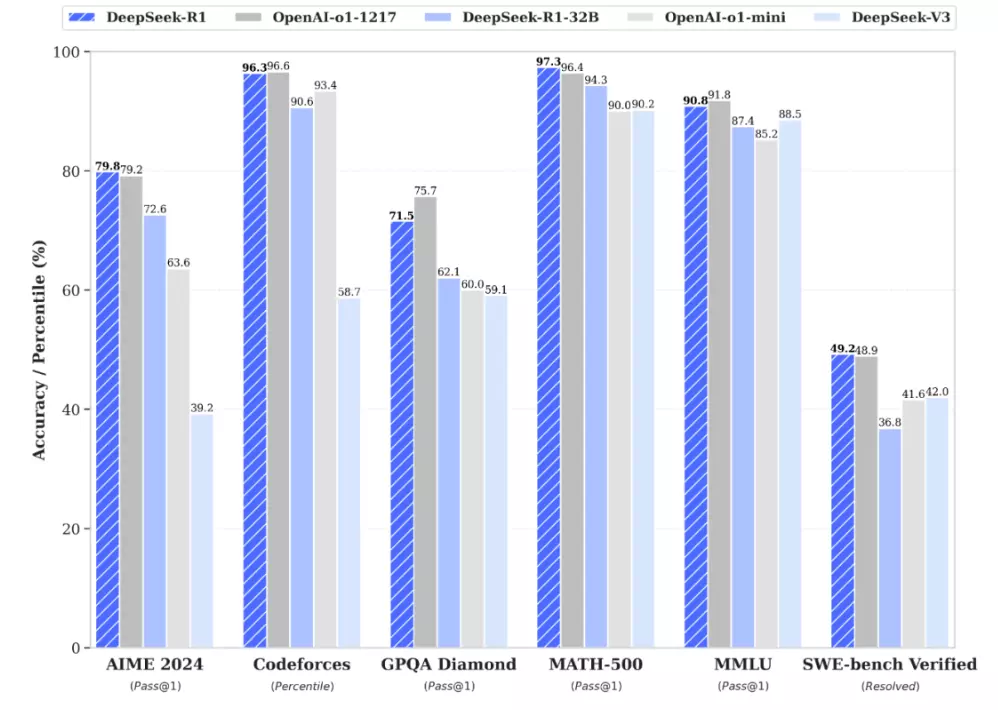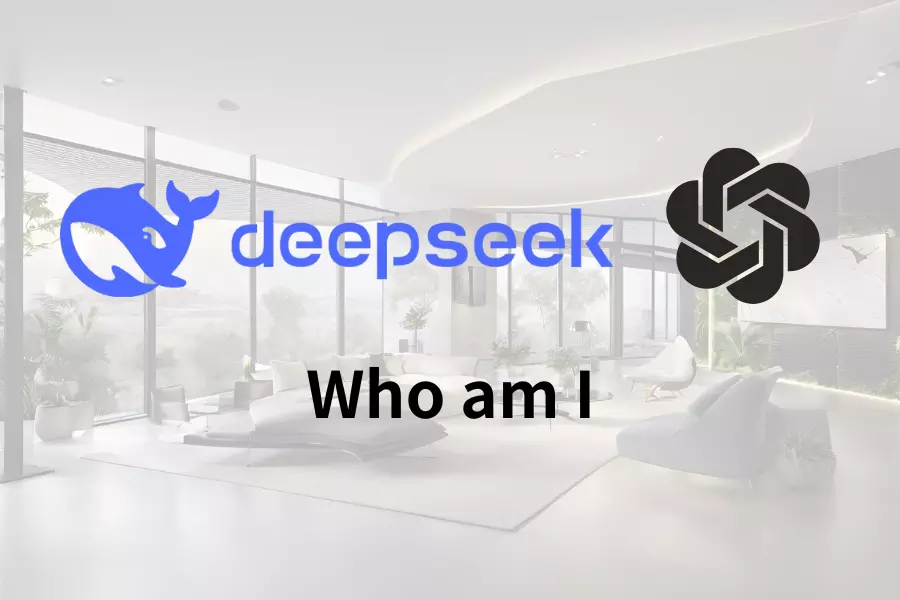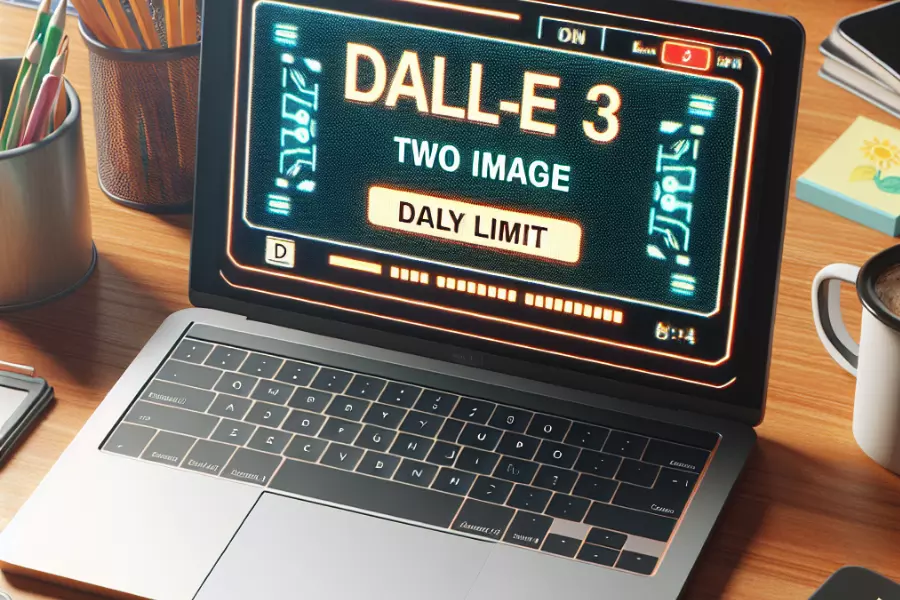DeepSeek R1: Open Source AI Model Revolution, Challenging OpenAI’s Dominance
Chinese AI lab DeepSeek has launched a new open-source reasoning model, DeepSeek R1, which not only matches OpenAI’s o1 in various benchmarks but is also available for download under the MIT license, marking a significant breakthrough in the AI field. This 67.1 billion parameter model demonstrates exceptional reasoning capabilities, potentially revolutionizing the accessibility of AI technology.
What is DeepSeek R1? — A Breakthrough Open-Source Reasoning AI Model
DeepSeek R1 is an advanced AI model focused on reasoning capabilities, designed to mimic human logical thinking and solve complex problems. It not only boasts a massive model size but also showcases outstanding performance in various benchmarks, bringing new breakthroughs to the AI field.
Model Architecture and Core Advantages
The core advantage of DeepSeek R1 lies in its powerful reasoning capabilities, thanks to the following key features:
- Massive Model Size and Exceptional Performance: The main model has 67.1 billion parameters, enabling it to excel in complex reasoning tasks. For example, in benchmarks like AIME, MATH-500, and SWE-bench Verified, R1 has shown performance comparable to or even surpassing OpenAI’s o1.
- Unique “Reasoning During Reasoning” Approach: R1 doesn’t just memorize and match patterns; it simulates human thought chains, breaking down problems step-by-step to derive answers, making it better at handling tasks requiring logical reasoning, such as mathematical proofs and physics problem analysis.
- Open Source with MIT License: DeepSeek R1 is open-sourced under the MIT license, meaning researchers and developers can freely use, modify, and distribute the model, accelerating the popularization and development of AI technology.
- Significantly Reduced Usage Costs: Compared to other commercial models of similar scale, DeepSeek R1’s API call costs are much lower, allowing more developers to experience high-performance AI technology at a lower cost.
Diverse Application Scenarios
DeepSeek R1’s powerful reasoning capabilities make it applicable in various fields:
- Mathematics and Scientific Research: R1 can assist researchers in solving complex mathematical problems, analyzing physical phenomena, and accelerating scientific discoveries.
- Programming and Software Development: R1 can help programmers write code, debug, and improve development efficiency and code quality.
- Education and Learning: R1 can serve as a powerful learning tool, helping students understand complex concepts, solve difficult problems, and provide personalized learning experiences.
Model Family
DeepSeek offers multiple model versions of different sizes to suit various hardware environments and application needs:
- Main Model: 67.1 billion parameters, suitable for complex tasks requiring high performance.
- Small Models: Parameter sizes range from 150 million to 7 billion, capable of running on resource-limited devices like laptops, meeting broader application needs.
DeepSeek R1 has demonstrated outstanding performance in multiple rigorous benchmarks, particularly excelling in tasks requiring complex reasoning.
Benchmark Results: Surpassing Peer Models
DeepSeek R1 has achieved impressive results in the following key benchmarks:
- AIME (American Invitational Mathematics Examination): Evaluates high school students’ excellence in mathematics, featuring a series of challenging math problems. R1 scored 79.8% in AIME 2024, showcasing its strong mathematical reasoning capabilities.
- MATH-500: A dataset containing 500 medium-difficulty math word problems, designed to assess a model’s ability to solve real-world math problems. R1 achieved an astonishing 97.3% on MATH-500, far surpassing many models of similar scale.
- SWE-bench Verified: A benchmark for evaluating code generation and understanding, focusing on code correctness and efficiency. R1 also performed exceptionally well in this test, proving its potential in programming applications.

Image Source: https://api-docs.deepseek.com/news/news250120
Comparison with OpenAI o1: According to data released by DeepSeek and multiple evaluations, R1 has shown performance comparable to or even surpassing OpenAI’s o1 in the aforementioned benchmarks, particularly excelling in mathematical reasoning and programming. This proves that R1 has reached industry-leading standards.
Expert Reviews: Peeking into the Model’s Thought Process
Renowned AI researcher Simon Willison, after testing R1, stated: “Each response comes with a <think> tag, showcasing the reasoning process. Observing the model’s thinking is fascinating.”
The Significance of <think> Tags: This is a unique feature of DeepSeek R1. It uses <think> tags to mark the model’s thought process at each reasoning step while generating answers. This not only allows users to better understand how the model reaches conclusions but also provides valuable analytical data for researchers, helping to deeply understand the model’s internal mechanisms. This “explainability” is crucial for the development of AI technology.
In addition to benchmark results, DeepSeek R1 also has advantages in the following areas:
- Inference Speed: R1 maintains high performance while also offering fast inference speeds, making it suitable for scenarios requiring real-time responses.
- Cost Efficiency: DeepSeek R1 is open-sourced under the MIT license and offers relatively low-cost API services, significantly reducing usage costs and allowing more developers to experience high-performance AI technology.
One of the highlights of DeepSeek R1 is its MIT open-source license model. This contrasts sharply with the closed-model strategies adopted by companies like OpenAI, signaling a new trend in AI development.
MIT Open Source License: Unleashing AI’s Infinite Potential
DeepSeek R1’s choice of the MIT license means:
- Completely Free to Download and Use: Anyone can download DeepSeek R1’s model weights, code, and related resources for free without any cost.
- Allows Commercial Use: Developers can build commercial products and services based on DeepSeek R1 without worrying about licensing issues.
- Encourages Open Research and Innovation: The MIT license encourages community participation in model improvement and expansion, promoting global AI research collaboration and innovation.
- Fully Transparent Training Details: DeepSeek has not only open-sourced the model but also disclosed its training data, methods, and processes, which is significant for academic research and technological development.
This open licensing model breaks the long-standing monopoly of large language models by a few companies, creating unprecedented opportunities for the popularization and development of AI technology.
Global Impact of Open Source Strategy: Accelerating AI Democratization
DeepSeek R1’s open-source strategy is expected to have a profound impact on the global AI industry, research, and society:
- Lowering the Barrier to AI Technology: Open source reduces the cost and technical barriers for developers to use and research large language models, enabling more small businesses, startups, and individual developers to participate in AI development and applications.
- Promoting Global AI R&D Collaboration: Open source fosters communication and collaboration among global researchers, accelerating the development and innovation of AI technology. The power of the community can quickly identify and fix model flaws, driving continuous improvement.
- Accelerating AI Democratization: Open source allows more people to access, understand, and use AI technology, breaking technological monopolies and promoting the popularization and application of AI, truly democratizing AI.
- Driving the Establishment of Technical Standards: Open source helps establish more open and transparent AI technical standards, promoting interoperability and compatibility between different models.
Potential Challenges and Considerations of Open Source
While open source brings many benefits, we must also face its potential challenges and considerations:
- Risk of Model Misuse: Open source makes it easier for malicious actors to misuse models for harmful purposes, such as generating fake news or conducting online fraud. The community needs to work together to establish corresponding regulatory and response mechanisms.
- Challenges of Community Maintenance: Maintaining a large open-source project requires significant resources and community support. Effectively organizing and managing the community to ensure the project’s long-term development is a major challenge.
- Exploring Business Models: How to build sustainable business models on an open-source foundation is a question that requires careful consideration.
Challenges and Limitations: Considerations Behind Openness
While DeepSeek R1’s open source is a significant advancement, we must also acknowledge the challenges and limitations it faces.
Content Moderation: Necessary Measures Based on Regulations
The cloud-hosted version of DeepSeek R1 (i.e., the version accessed via API) must comply with Chinese regulations, leading to content moderation. This means:
- Filtering Sensitive Topics: The model filters content involving politically sensitive, pornographic, violent, or hate speech. Specific filtering mechanisms may include keyword filtering and semantic analysis.
- Aligning with “Core Socialist Values”: The model’s output must align with the “core socialist values” advocated by the Chinese government. This may result in differences in the model’s responses on certain topics compared to other regions.
- Impact on Users: Users of the cloud-hosted version may not receive complete or objective information on certain topics.
Flexibility of Local Deployment: Unlike the cloud-hosted version, the locally deployed version (i.e., the version where users download and run the model on their own servers) is not subject to the above content moderation. Users can adjust the model’s behavior and output according to their needs. However, local deployment also requires users to take responsibility for server maintenance and content management.
Technical Challenges: Room for Continuous Improvement
DeepSeek R1 still faces some technical challenges:
- Computational Resource Requirements: As a large language model with 67.1 billion parameters, DeepSeek R1 requires powerful computational resources to run effectively. Local deployment requires servers with high-end GPUs, while cloud hosting incurs corresponding computational costs.
- Inference Speed: Although DeepSeek R1 performs well, its inference process is still relatively time-consuming compared to some smaller models. This may affect the user experience in scenarios requiring real-time responses.
- Model Accuracy and Reliability: While R1 performs well in many benchmarks, it may still produce errors or inconsistent outputs when handling complex or rare tasks. Model accuracy and reliability need to be improved through continuous training and validation.
- Explainability and Bias: Like many large language models, DeepSeek R1’s internal mechanisms remain relatively difficult to explain. This makes it hard to fully understand how the model reaches conclusions. Additionally, the model may be influenced by data biases during training, leading to unfair or inaccurate outputs on certain topics.
Other Potential Challenges
In addition to the above challenges, DeepSeek R1 faces some other potential challenges:
- Risk of Model Misuse: Open source makes it easier for models to be used for malicious purposes, such as generating fake news or conducting online fraud.
- Challenges of Community Maintenance: Maintaining a large open-source project requires significant resources and community support.
DeepSeek R1’s Profound Impact on the AI Ecosystem
The launch of DeepSeek R1 is not just a new AI model; it may have a profound impact on the entire AI ecosystem, from technological breakthroughs to industry competition, and even broader societal implications.
DeepSeek R1’s technological breakthroughs are mainly reflected in the following aspects, which will directly promote the popularization of AI applications:
- Significant Improvement in Reasoning Capabilities: R1 focuses on optimizing reasoning capabilities, making it excel in tasks requiring logical reasoning, such as mathematics and coding. This means AI can not only perform simple recognition and classification tasks but also handle more complex analysis, decision-making, and creative tasks, such as automated code generation, complex problem-solving, and scientific research assistance.
- Possibility of Running Advanced AI on Local Hardware: DeepSeek offers multiple model versions of different sizes, with smaller models even capable of running on consumer-grade hardware like laptops. This significantly lowers the barrier to using advanced AI technology, allowing more developers and researchers to conduct AI experiments and application development locally, accelerating the popularization of AI technology.
- Opening New Paths for Scientific Research and Technological Innovation: R1’s open-source nature and high reasoning capabilities open new paths for scientific research and technological innovation. Researchers can use R1 for more complex simulations, analyses, and predictions, accelerating scientific discoveries. Developers can build smarter and more powerful applications based on R1, such as intelligent assistants, automation tools, and educational platforms.
Industry Competition: Reshaping the Global AI Landscape
The emergence of DeepSeek R1, along with the rise of Chinese AI companies like Alibaba and Moonshot AI, is reshaping the global AI competition landscape:
- Breaking the U.S. Dominance in Large Language Models: U.S. companies have long dominated the large language model field. The emergence of DeepSeek R1 and the rapid development of other Chinese AI companies are breaking this dominance, promoting the diversified development of global AI technology.
- Accelerating the Open-Source Trend in AI Technology: DeepSeek R1’s open-source strategy may lead more companies to follow suit, accelerating the open-source trend in AI technology. This will promote global AI community collaboration and innovation, speeding up the development and popularization of AI technology.
- Promoting Diversified Development of AI Applications: Chinese AI companies have unique advantages in exploring and innovating application scenarios, such as in mobile payments, e-commerce, and smart cities. These application experiences and technological accumulations will drive the diversified development of global AI applications.
DeepSeek R1’s impact is not limited to technology and industry; it will also affect the broader ecosystem:
- Contribution to the Open-Source Community: R1’s open-source nature provides a valuable resource for the global AI open-source community, promoting communication and collaboration within the community and driving the development of the open-source AI ecosystem.
- Impact on Education: R1’s emergence provides new tools and resources for AI education, enabling more people to learn and understand AI technology, cultivating future AI talent.
- Impact on Society: The popularization and application of AI technology will have profound impacts on various aspects of society, such as improving production efficiency, enhancing quality of life, and driving social progress.
Frequently Asked Questions (FAQ)
To help you better understand DeepSeek R1, we’ve compiled some common questions:
Q1: What are the main differences between DeepSeek R1 and OpenAI’s o1?
A: The main differences between DeepSeek R1 and OpenAI’s o1 are as follows:
- Licensing Model: R1 uses the MIT open-source license, completely free and allowing commercial use, including modification and redistribution. In contrast, o1 is a closed model with restricted usage.
- Accessibility: R1 offers multiple model versions of different sizes, with smaller versions capable of running on consumer-grade hardware like laptops, significantly lowering the barrier to entry. o1 primarily provides services via API, requiring higher costs and technical thresholds.
- Training Methods: R1 uses a reinforcement learning-based training approach, focusing on improving the model’s reasoning capabilities. o1’s training methods are more complex, involving multiple stages and techniques.
- Cost Efficiency: R1’s open-source nature and relatively low-cost API services give it a clear advantage in cost efficiency.
Q2: Can I use DeepSeek R1 for commercial purposes?
A: Yes. R1 is open-sourced under the MIT license, meaning you can freely use it for commercial purposes, including developing products, providing services, modifying, and redistributing it without any licensing fees.
Q3: What are the requirements for local deployment? What are the differences between different model versions?
A: Local deployment requirements depend on the model version you choose:
- Small Models (150 million to 7 billion parameters): These versions can run on laptops or desktops with mid-to-high-end CPUs and a small amount of memory, suitable for individual developers or small teams for experimentation and development.
- Medium Models (tens of billions of parameters): These versions require servers with multiple high-end GPUs and a large amount of memory to run effectively, suitable for applications needing to handle more complex tasks.
- Large Models (67.1 billion parameters): This is R1’s main model, requiring servers with multiple top-tier GPUs and massive memory to achieve optimal performance, suitable for highly complex tasks like scientific research and large-scale data analysis.
The choice of version depends on your hardware resources and application needs.
Q4: What are the main application scenarios for DeepSeek R1?
A: DeepSeek R1’s powerful reasoning capabilities make it applicable in various fields:
- Mathematics and Scientific Research: Solving complex mathematical problems, analyzing physical phenomena, conducting scientific simulations, etc.
- Programming and Software Development: Automated code generation, debugging, code analysis, etc.
- Education and Learning: Providing personalized learning experiences, helping students understand complex concepts, solving difficult problems, etc.
- Natural Language Processing: Text summarization, question answering, translation, dialogue, etc.
A: DeepSeek R1 has demonstrated exceptional performance in multiple benchmarks, particularly excelling in mathematical reasoning and programming. According to data released by DeepSeek and multiple evaluations, R1 has shown performance comparable to or even surpassing OpenAI’s o1 in benchmarks like AIME, MATH-500, and SWE-bench Verified.
Conclusion: A Major Milestone in AI Democratization
The launch of DeepSeek R1 is not just a technological breakthrough but also a significant milestone in the democratization of AI technology. Through open and accessible means, it is reshaping our imagination of artificial intelligence, allowing more people to participate in AI development and applications. R1’s open-source strategy is expected to accelerate the development and popularization of AI technology, promote global AI community collaboration and innovation, and ultimately enable AI technology to better serve human society. We look forward to DeepSeek R1 achieving greater success in the future and bringing more surprises to the AI field.
Special Note: This article is based on technical documents and research reports released by DeepSeek.






